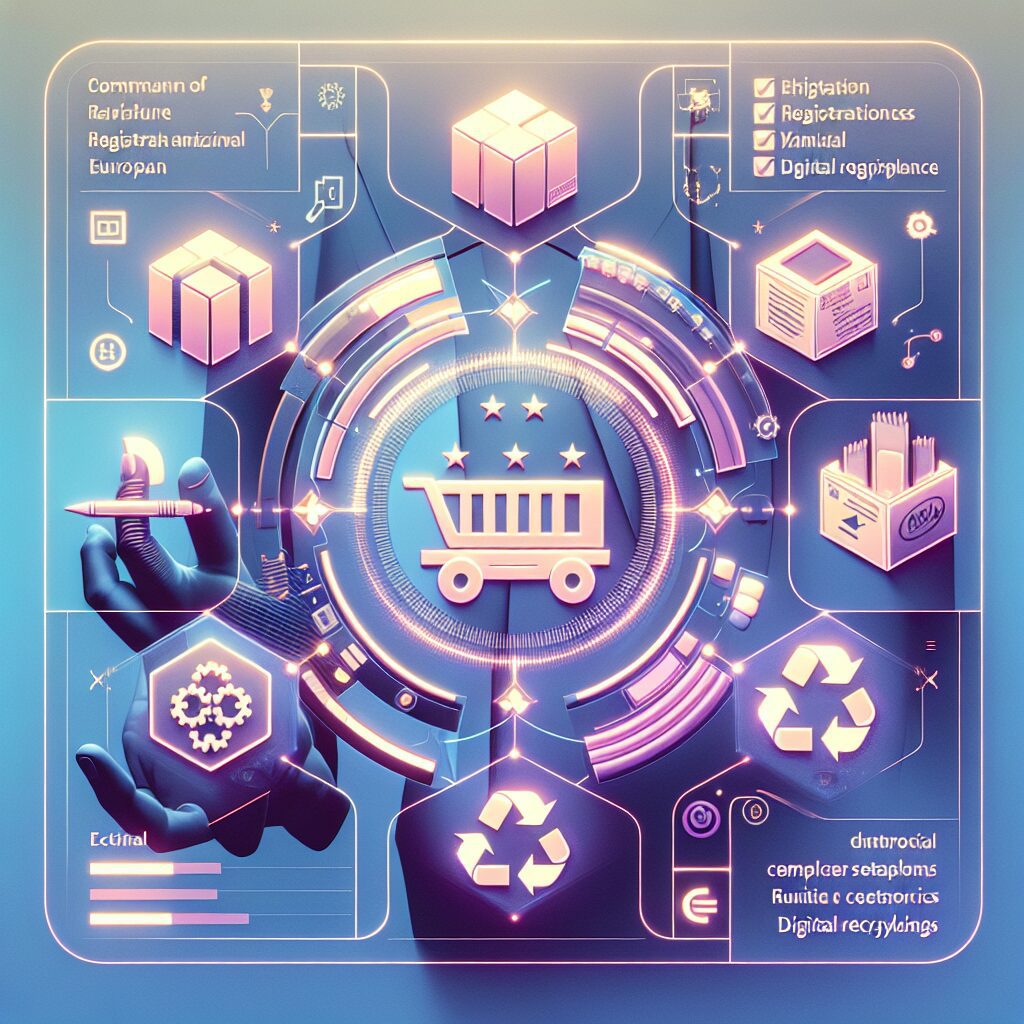About eldris
At Eldris, we automate SEO, multilingual site expansion, and EU compliance for brands scaling across Europe. Our AI-powered platform handles everything from content publishing to regulatory docs—so you don’t have to.
In This Article
- Register for WEEE compliance in every EU country where you sell.
- Confirm your role as producer, importer, or brand to determine liability accurately.
- Join an approved compliance scheme for support and efficiency.
- Label all products with the correct WEEE symbol and maintain clarity in documentation.
- Maintain accurate, timely reporting to meet EU data retention policies.
- Stay ahead of 2024 changes by digitalising your compliance process.
Why WEEE Compliance Matters for EU Sellers
Legal and Environmental Incentives
WEEE compliance is not merely a bureaucratic necessity; it’s a fundamental regulatory obligation for businesses selling electrical and electronic equipment (EEE) in the European Union. Introduced to reduce environmental impact and ensure proper disposal of e-waste, the WEEE Directive imposes specific duties on producers, importers, online retailers, and fulfilment providers. If you are an Amazon seller or operate through any other platform that enables trade within the EU, you are very likely subject to these rules. Failure to meet WEEE compliance mandates can result in severe penalties, sales restrictions, and reputational damage.
Moreover, aligning with WEEE compliance initiatives underlines your brand’s environmental responsibility. With sustainability high on consumer agendas, transparent adherence to e-waste handling protocols boosts customer trust, fosters loyalty, and may even open doors to green procurement markets. In an age where climate impact has reached centre stage, we must acknowledge the legal and ethical imperatives of sustainable product end-of-life management.

Understanding the WEEE Directive
Scope of Covered Products and Seller Types
The WEEE Directive (Directive 2012/19/EU) governs the collection, recycling, and recovery of waste electrical and electronic equipment. It applies to a wide range of product categories, including large and small household appliances, IT equipment, consumer electronics, lighting fixtures, medical devices, and automatic dispensers. The definition of EEE is broad: if your product relies on electric currents or electromagnetic fields to function, then it likely falls under the directive’s scope.
Importantly, sellers based outside the EU are also obligated to ensure WEEE compliance if their products reach EU consumers. By “placing on the market”, the directive means the first instance when a product is made available for distribution or use within the EU. This includes B2B and B2C transactions. Amazon sellers, Etsy traders, and even smaller Shopify-run stores may qualify as “producers” under WEEE, especially if no EU-based representative or importer is declared.
“A failure to understand the WEEE scope can lead to inadvertent non-compliance — ignorance is not a defence under EU law.”
Step-by-Step: EU Country Registration
Each EU member state manages its own WEEE compliance registry and enforcement agency. Therefore, registration must be performed individually for any country where your products are sold. Here is a step-by-step approach to ensure you’re correctly registered in each applicable jurisdiction:
Understanding Producer Responsibility
You must first determine whether your business qualifies as a producer. If you manufacture EEE products, import them into the EU, or sell under your brand name, then you are a producer under WEEE rules. In the absence of a local entity assuming this role, you should appoint an authorised representative (AR) based in the target member state.
Initiating National WEEE Registration
Visit the relevant national WEEE agency’s web portal or compliance authority. Submit documentation such as your VAT number, company registration data, and detailed product information including product category, brand names, and EANs. You must also indicate the estimated volume of products to be placed on the market annually.
Once registered, a producer number will be issued. This number must be included in your product labelling and referenced in filings. In some states, such as Germany and France, additional packaging and battery take-back obligations may apply. Therefore, Learn more about EU Product Compliance & Legal Requirements for understanding multi-stream compliance is essential.
Choosing the Right Compliance Scheme
WEEE compliance schemes serve as intermediaries between producers and WEEE enforcement bodies. They take on obligations such as waste collection logistics, reporting, and financing of recycling infrastructure. It is mandatory in several EU countries to operate via an approved compliance scheme rather than being self-registered as an individual entity.
When choosing a scheme, compare pricing structures, service coverage (particularly if you sell across borders), customer service quality, and reputation. Some schemes specialise in specific verticals (e.g., B2C electronics or industrial medical devices) which may offer more tailored support. Engage legal counsel or a consultancy where needed to avoid signing up to sub-optimal plans.
Labelling Your Products with the WEEE Symbol
According to the WEEE Directive, compliant products must display the “crossed-out wheeled bin” symbol to indicate to users that the item should not be disposed of with regular household waste. The symbol must be clearly visible, indelible, and appear either on the product itself or, where this is not practical, on its packaging or accompanying documentation.
Additional Requirements
In some cases, a bar below the bin (indicating post-2005 product placement on the market) is also necessary. Ensure accurate symbol sizing proportionate to product scale and follow EU guidance for high-durability labelling methods. Products lacking proper markings may be rejected at customs or returned, damaging the seller’s bottom line.
Reporting Duties and Data Requirements
WEEE compliance does not stop at initial registration. Ongoing reporting is essential to maintain your legal standing. Typically, data must be submitted quarterly or annually, detailing volumes (in weight and units) of EEE placed on the market, collected, recycled, and recovered. Disaggregation by product category is also mandated.
Many compliance schemes offer reporting templates, but sellers remain legally accountable for data accuracy. Products sold through multiple channels must be aggregated, and returns must be reported accurately—especially if refurbished and re-sold. False reports can result in steep regulatory fines.
Keep Records Thoroughly
Always store supporting purchase and shipping documentation for audit purposes. The EU requires producers to retain data for a minimum of 5 years in certain states. Consider adopting automated tracking systems to manage data integrity over time.
Who Is Liable: Amazon Sellers, Importers & Brands
The fragmented nature of B2C and B2B ecommerce makes WEEE liability complicated. If you’re an Amazon seller and no authorised EU-based representative is named, then Amazon may suspend your products until WEEE obligations are fulfilled. This is particularly common since Germany, France, and Spain began requesting Extended Producer Responsibility (EPR) registration ID numbers for WEEE.
Importers—those who distribute products from outside the EU into member states—are also liable as producers, regardless of brand ownership. Conversely, EU-based brand owners selling directly assume full WEEE responsibilities, including registration, labelling, and take-back commitments. Clarify your supply chain to ensure every necessary role is accounted for and prevented from lapsing into non-compliance.
Penalties for Non-Compliance
Penalties for WEEE non-compliance vary by country but can include formal warnings, product delistings, daily fines, sales bans, and even criminal prosecution for repeat or wilful violations. In Germany, the Stiftung EAR registry can issue takedown orders, while in France, the ADEME can revoke authorisations to sell entirely.
Moreover, marketplaces like Amazon and eBay now require sellers to upload EPR evidence directly in platform dashboards. Missing documentation will lead to deactivation of listings. Read a related article to learn how to keep your selling privileges intact while navigating cross-border compliance.
Managing Compliance Across Multiple EU States
Multinational sellers must juggle compliance in several languages, formats, and legal interpretations. Selling the same product in France and Italy may require two different authorised representatives, discrete reporting formats, and separate recycling charges.
To manage this complexity efficiently, consider combining product data into a centralised ERP solution or WEEE management platform. It’s also advisable to work with pan-European compliance schemes or service providers. They can facilitate bulk country registrations, harmonise your data outputs, and ensure regulation-specific deadlines are met.
Using Technology to Simplify WEEE Reporting
New software solutions now allow sellers to automate WEEE reporting and integrate it directly into shipping, inventory, and sales platforms. These tools track sales volumes by jurisdiction, categorise products according to EU registers, and produce ready-to-submit compliance data.
AI-powered tagging also helps classify grey-area products correctly—a major boon for sellers with mixed-use items. Investing in the right tools ensures data integrity, lowers audit risks, and reduces internal staffing burdens. Official WEEE responsibilities for EU sellers to explore a leading compliance automation platform used by top ecommerce exporters.
2024 Compliance Updates and Upcoming Changes
As of 2024, several amendments to the WEEE Directive are under review. These include potential updates to product categorisation, weight thresholds, and end-of-life financing obligations. Countries like the Netherlands are also setting stricter take-back ratios for specific equipment types, which could affect retailer obligations.
Digitisation is a consistent theme in 2024 changes, with more countries mandating digital filing, establishing online compliance dashboards, and issuing digital EPR certificates to simplify enforcement. It’s crucial for sellers to monitor updates through national registers or consult with legal specialists.
Conclusion: Action Plan for Compliant Selling
[CONCLUSION_CONTENT]
Great guide on achieve-weee-compliance-eu-sellers-interactive – Community Feedback
What does WEEE compliance mean for EU sellers?
WEEE compliance means fulfilling all legal requirements under the EU’s Waste Electrical and Electronic Equipment directive, including registering, labelling products, reporting sales, and financing proper collection and recycling procedures within each country where products are sold.
How do I register for WEEE as an online seller?
You must register as a WEEE producer with the appointed authority in every EU country you sell EEE. Obtain a registration number, join a compliance scheme (if required), mark products with the WEEE symbol, and submit regular reports on products placed on the market.
Who is responsible for WEEE compliance in the EU?
Manufacturers, importers, or sellers placing electronic or electrical goods on EU markets are responsible for WEEE compliance. Each party must fulfil registration, labelling and reporting duties in every EU country where products are sold.








